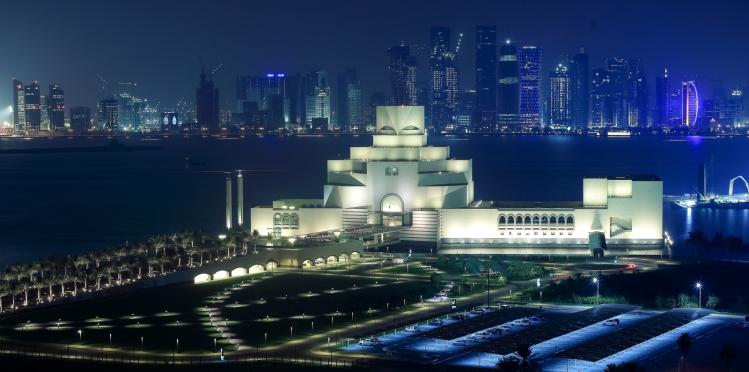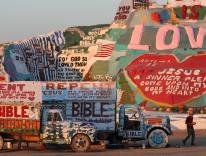
The State of Qatar, which protrudes into the Persian Gulf with Saudi Arabia to its south and Iran to its north, is only a little larger than Connecticut. Despite its size, however, it is an excellent place to observe current affairs, not least those pertaining to religion. This is what I learned during a recent visit to Doha’s decade-old International Center for Interfaith Dialogue—the first institution of its kind in the religiously conservative, historically inward-looking Gulf States.
Qatar became independent of Great Britain in 1971, and has since sprinted into modernity, funded by abundant natural-gas fields. A few decades ago, it was a tribal desert society with an economy based on pearl diving, fishing, and camel and horse breeding. Now it is, per capita, the wealthiest country in the world, with a skyline catching up to many major cities.
Buildings reflect commercial and governmental needs, but culture is also part of the mix. In 2008, Doha opened a new Museum of Islamic Art, designed by the celebrated I. M. Pei and holding some of the most exquisite examples of Islamic art in the world. Pei took the commission on the condition that Qatar build an artificial peninsula into the Gulf to showcase his work. Qatar agreed.
Development continues frenetically, barreling toward 2022, when Qatar will host the World Cup. Several money-is-no-object stadium projects dot the skyline, along with other works of urban infrastructure. Promising to “Deliver Amazing” in its campaign to host the event, and beating out the United States, Japan, South Korea, and Australia for the honor, the country candidly recognizes this as a bid for “soft power.” It wants to punch above its weight on the world stage.
Home to the most popular media outlet in the Middle East, Al-Jazeera, Qatar is also rapidly becoming a regional center for higher education. Its 2,500-acre “Education City” in Doha has lured major American universities—Texas A&M, Georgetown, Cornell, Northwestern—to set up not simply study-abroad centers, but entire satellite campuses. One might receive advanced degrees from these and other institutions without ever leaving the tiny kingdom.
Yet beneath the razzle-dazzle lurks disquiet. Power is heavily concentrated in several leading tribes, led by the Al Thani family and its leader, Sheikh Tamim bin Hamad, who took over from his father, Sheikh Hamad bin Khalifa, in 2013. Mao-ish images of father and son appear everywhere in the country. Decision-making processes in the kingdom’s majlis (tribal council) remain shrouded in secrecy and intrigue. And while Al-Jazeera might report on the mischief of other countries’ royalty, the Al Thani clan is off limits. Freedom of press is largely an export commodity, not a domestic good.
Most Qataris adhere to the traditionalist Wahhabi brand of Islam. A mammoth new mosque, dedicated to the Wahhabi leader Muhammad ibn Abd al-Wahhab (1703–1792) opened in 2011 and offers a stunning view of Doha. Many Wahhabis subscribe to a strict interpretation of a hadith forbidding non-Muslims and their sites of worship to be anywhere near the holy sites of Mecca and Medina. In their view, that means anywhere on the Arabian peninsula, including Qatar.
This raises delicate questions about the huge migrant workforce in Qatar, many of whom are not Muslims. Strangely, Qataris are a minority in their own country (roughly 20 percent of the population), the rest being foreign laborers from the Philippines, India, Nepal, Bangladesh, Pakistan, Sri Lanka, and several other countries. Often living in cramped, no-frills quarters away from Doha’s urban splendor, these workers have limited opportunities for worship if they are not Muslim. This reality is common to most Gulf States, and Pope Francis rightly placed a spotlight on it in his recent trip to the United Arab Emirates.
With other Gulf countries, Qatar has established a “religious complex”—essentially a surveilled and heavily fortified compound on the outskirts of Doha where “people of the book,” mainly Christians, are allowed to worship. Christians refer to it as “church city.” Opened in 2008, the compound houses Catholic, Orthodox, Coptic, Syriac, and Anglican churches, offering services in multiple languages. Bewildered by the multiplicity of Protestant denominations, the Ministry of Foreign Affairs, which oversees the complex, tasked Anglicans with attending to the religious needs of all Protestants—an ecumenism of bureaucratic fiat, one might say. For lack of transportation, many Christians cannot make it to the “church city,” and they are not permitted to worship publicly elsewhere.
The complex is a reminder of the vanished Ottoman-era “millet system,” which gave Abrahamic faiths some autonomy to mind their own affairs, so long as they kept apart from the Muslim population. Qataris are forbidden to visit the complex, and both its location and sterile design were intentional, according to the social anthropologist John Fay. They are meant, he said, to keep the place “out of sight and out of mind.” Proselytization and charity work are both strictly forbidden to Christians.
In this arrangement, South Asian Buddhist and Hindu workers (among others) have no places of worship. The government does not interfere if they worship in private, I was told by the governmental minister who directs the Interfaith Center, but they are not recognized in any official way. When I asked if the center engages the thought of Buddhism or Hinduism, I was told matter-of-factly that, according to sharia, these are not considered religions at all, but are rather “man-made philosophies.” Qatar desires peaceful coexistence with them, but not open dialogue. Indian Prime Minister Narendra Modi wants Qatar to allow the construction of a Hindu temple, but his requests have been largely ignored.
The migrant workforce must often endure unsanitary living situations and harsh working conditions in extremely high temperatures. Both Amnesty International and Human Rights Watch have issued reports highlighting these problems. In the past, workers have labored under the so-called “kafala” system, which tied them to a single employer, making it very difficult to change jobs or travel home. To most Qataris, migrant workers appear as dusty blurred images glimpsed from the windows of sleek Western cars.
Thanks to prodding from the International Labour Organization, there have been some improvements. Still, as I was told by a Western white-collar worker, cruel abuses persist, perpetrated not directly by the Qatari government but by unscrupulous contractors. Many workers make it to Qatar only with the help of middlemen, and spend their initial years as indentured servants paying back a “recruitment fee.”
A tiny state in a tough neighborhood, Qatar has pursued a curious strategy of friendship with all. But this has sometimes backfired. Remarkably, the country is home to the largest U.S. military base in the Middle East, even as the Taliban maintains offices in Doha. Qatar counts both Turkey and Iran as friends and has supported various Islamist groups, including Hamas and the Muslim Brotherhood. Friendship with groups that seek to depose the Gulf’s hereditary rulers, along with complaints about Al-Jazeera, recently led to a dust-up with Saudi Arabia, which cut diplomatic ties to Qatar in 2017 and now heads up an embargo supported by several other countries in the region. It is now easier to fly from Chicago than from Doha to many airports in Middle Eastern cities, as I discovered.
What lies in Qatar’s future? Can a country that has pursued such precipitate modernization coexist with ancient tribal political structures and Wahhabist Islam? Right now spigots of natural gas seem to make all things possible. But fissures appear here and there. Exposure to Western education, according to Georgetown professor Leo D. Lefebure, has allowed young Qataris to see that their prior learning only gave them “extremely negative attitudes toward all other religions.” Some young people complain that they live in a cosseted, cash-rich fantasy world overseen by paternalistic overlords. As in other Muslim-majority countries, women find themselves at the center of polarizing political and theological debates. Many Qatari women live in a mostly veiled world and are subjected to highly traditionalist interpretations of sharia law on marriage and gender relations. And what of the unwashed masses, toiling away at Qatar’s insta-modernity in unforgiving heat?
At the World Cup in 2022, an estimated 1.5 million visitors will pour through Hamad International Airport. The country will stand in the global spotlight as no other Gulf State has. Will Qatar “Deliver Amazing”? Stay tuned.
